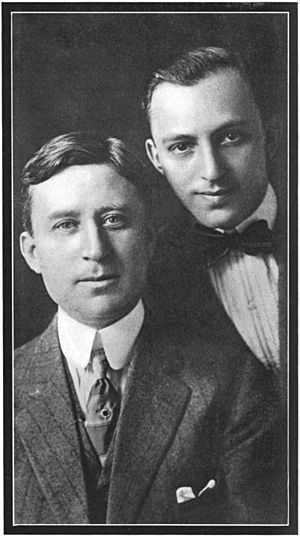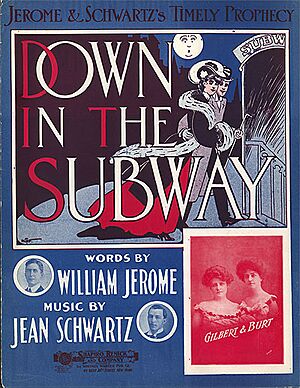William Jerome facts for kids
William Jerome Flannery (born September 30, 1865 – died June 25, 1932) was an American songwriter. He was born in Cornwall-on-Hudson, New York. His parents, Mary Donnellan and Patrick Flannery, were immigrants from Ireland. William Jerome worked with many famous composers and performers. He is best known for working with Jean Schwartz for about ten years. Together, they created many popular songs and musical shows in the early 1900s.
Contents
William Jerome's Early Life and Career
William Jerome started singing and dancing in vaudeville shows when he was seventeen. Vaudeville was a popular type of entertainment with many different acts. He traveled with various shows and met Eddie Foy, another performer. They became good friends and often worked together.
By the late 1880s, Jerome was performing as a singer who made fun of popular songs at a famous theater called Tony Pastor's. He also began writing his own songs, and they became quite successful. In 1891, he wrote "He Never Came Back." Eddie Foy sang this song in a musical called Sinbad, and it became a big hit.
Throughout the 1890s, Jerome kept performing. His skill as a lyricist (someone who writes song words) grew steadily. In 1894, he wrote "My Pearl is a Bowery Girl" with Andrew Mack. This song became a number one hit for singer Dan W. Quinn.
Jerome married another vaudeville singer named Maude Nugent around the early 1890s. They had at least one child, a daughter named Florence, born in 1896. Some people say that Jerome helped Harry Dacre with the bicycle lyrics for the famous song "Daisy Bell" (1892).
Working with Jean Schwartz
William Jerome first worked with songwriter Jean Schwartz in 1901. Their first song together was "When Mr. Shakespeare Comes to Town."
Big Hits and Popular Songs
In 1902, the duo wrote "Mr. Dooley." This song was added to a musical called A Chinese Honeymoon when it came to America. A Chinese Honeymoon was very popular, and "Mr. Dooley" became famous. Later that year, the song was also added to The Wizard of Oz stage play, which made it even more popular. It is said that "Mr. Dooley" sold over a million copies!
Their next huge hit was "Bedelia" (1903). This song was sung by Blanche Ring in a show called The Jersey Lily. "Bedelia" sold more than three million copies! By 1904, four different singers had recorded "Bedelia" on the main record labels of the time.
In 1904, Jerome and Schwartz wrote the music for a musical called Piff! Paff!! Pouf!!!, which starred Eddie Foy. They went on to create music for seven more musicals together.
Jerome and Schwartz became two of the most recognized songwriters of the early 1900s. They had many popular songs, including:
- "My Irish Molly-O" (1905)
- "Handle Me With Care" (1907)
- "Over the Hills and Far Away" (1908)
- "Meet Me in Rose Time, Rosie" (1908)
One of their most famous songs is "Chinatown, My Chinatown" (1906). It wasn't a big hit right away. Four years after they wrote it, Eddie Foy added it to his show Up and Down Broadway. Five more years passed, and then it became a national hit record. Today, it is known as a jazz standard, which means it's a very important and often-played jazz song.
Starting Their Own Company
In 1911, Jerome and Schwartz started their own company to publish sheet music. They mostly published songs with music by Schwartz. Many of these songs had lyrics by Jerome, like "If It Wasn't for the Irish and the Jews" (1912). They also published songs with lyrics by Grant Clarke.
Around this time, Jerome also started working more with other composers. In 1912, he wrote the lyrics for "Row, Row, Row." The music was by James V. Monaco, and the song was for the Ziegfeld Follies, a famous series of Broadway shows. In 1913, he worked with Andrew B. Sterling and Harry Von Tilzer on "On the Old Fall River Line." He also worked with Von Tilzer again on "And the Green Grass Grew All Around." Jerome and Schwartz worked together less and less, and eventually, they both moved on to other projects.
Later Career and Achievements
After his partnership with Schwartz ended, William Jerome continued to write songs with many well-known composers. In 1920, he wrote the lyrics for "That Old Irish Mother of Mine." The music was by Harry Von Tilzer, and Jerome dedicated the song to his mother's memory. He worked with Von Tilzer again on "Old King Tut" (1923). With Charles Tobias and Larry Shay, he wrote "Get Out and Get Under the Moon" (1928).
Jerome also continued to publish sheet music on his own. In 1917, he published the incredibly successful song "Over There" for George M. Cohan. He later sold the rights to this song to Leo Feist for $25,000. This was the most money ever paid for a song at that time!
Because he was good at writing Broadway comedies, Mack Sennett hired him as a writer for the Keystone Film Company. This company made many early silent films. Jerome was also one of the first board members (from 1914 to 1925) of the American Society of Authors, Composers and Publishers (ASCAP). This organization helps protect the rights of music creators.
William Jerome was hit by a car in the spring of 1932. He passed away on June 25 in Newburgh, New York.



